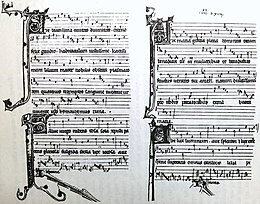Codex Montpellier (music manuscript)
The Codex Montpellier (also Mo) is a music manuscript of the Bibliothèque Interuniversitaire de Médecine in Montpellier with the signature H196. It is one of the most important sources for the early motet .
description
A first part of fol. 1-269 was created around 1280, a second part (fol. 270-333) at the end of the 13th century. Further pieces were found on fol. 334-345 and 346-349 added at the beginning of the 14th century. It is believed that the manuscript originally came from Paris. The pieces are recorded in pre-Franconian and Franconian mensural notation . There are some illuminated initials , and on these pages mostly marginal drawings that show either animals or people doing leisure activities.
The Codex Montpellier is the most extensive surviving moth manuscript of this time. It contains 328 compositions, mostly motets, only 11 compositions belong to other genres ( Conductus and Organum compositions in the style of the Notre Dame school ). The two- and three-part pieces predominate in the motets, but part of the manuscript also contains four-part motets. On the one hand there are motets with a spiritual theme, such as the well-known piece “Alle psallite cum luya”; especially numerous are those dealing with Mary . On the other hand, there are also numerous motets with secular themes - for example the motet “On parole” / “A Paris” / “Frese nouvelle”, which is about wine and fresh strawberries.
The manuscript shows a systematic layout in which the pieces were sorted according to genre, number of votes and language of the upper voices:
- Part 1 (fol. 1-22): Organa and Conductus;
- Part 2 (fol. 23-62): Motets in four parts;
- Part 3 (fol. 63-86): Three-part motets, texts in the triplum part in French, in the motetus part in Latin;
- Part 4 (fol. 87-110): Three-part motets, triplum and motetus part in Latin;
- Part 5 (fol. 111-230): Three-part motets, triplum and motetus part in French;
- Part 6 (fol. 231-269): Two-part motets;
- Part 7 (fol. 270-349) and 8 (fol. 350-397): Three-part motets, partly in the style of Petrus de Cruce .
See also
literature
- Edmond de Coussemaker: L'art harmonique aux XIIe et XIIIe siècles. Paris 1865.
- Gustav Jacobsthal : The texts of the song manuscript of Montpellier H 196. In: Journal for Romance Philology. Volume III, 1879, p. 526 ff. And Volume IV, 1880, p. 278 ff.
- Gustav Jacobsthal: The Codex Montpellier. Description and investigation , edited by Peter Sühring, only online: urn : nbn: de: bsz: 14-qucosa2-337475 , doi: 10.25366 / 2018.49
- Henri Lavoix: La musique au siècle de St. Louis. In: Gaston Raynauds Recueil de motets français de XIIe et XIIIe siècles publiés d'après les manuscripts. Avec introduction, notes, variants et glossaires. Volume 2. Paris 1883.
- Oswald Koller: The song code of Montpellier. A critical study. In: Guido Adler (Hrsg.): Quarterly journal for musicology. 4, 1888, pp. 1-82.
- Friedrich Ludwig : Studies on the history of polyphonic music in the Middle Ages II: The 50 examples of Coussemaker from the Montpellier manuscript. In: Anthologies of the International Music Society. Volume 5. 1903/1904, pp. 177-224.
- Yvonne Rokseth (Ed.): Black and white facsimile of the manuscript: Polyphonies du XIIIe siecle. Le manuscrit H 196 de la Faculté de Médecine de Montpellier. Reproduction phototypique du manuscrit. Paris 1935.
- Yvonne Rokseth: Polyphonies du XIIIe siècle. Le manuscrit H. 196 da le Faculté de médecine de Montpellier. 4 volumes:
- Tome I: Réproduction photographique du manuscrit. Paris 1935.
- Tome II / III: Transcription intégrale du manuscrit. Paris 1936/1939.
- Tome IV: Etudes et commentaires. Paris 1948.
- Ernst Apfel: Layout and structure of the motets in the Codex Montpellier. (= Annales Universitates Saraviensis. Series: Philosophical Faculty. Volume X). Heidelberg 1970.
- Hans Tischler: Why a New Edition of the Montpellier Codex? In: Acta musicologica. 46, 1974, pp. 58-75.
- Wolf Frobenius: On the genetic relationship between the Notre Dame clauses and their motets. In: Archives for Musicology . 44, 1987, pp. 1-39.
- Mary E. Wolinski: The Compilation of the Montpellier Codex. In: Early Music History. 11, 1992, pp. 263-301.
- The Montpellier Codex. The Final Fascicle. Contents, contexts, chronologies . Edited by Catherine A. Bradley, Karen Desmond, Woodbrige 2018.
- Peter Sühring : The power of refrains in the Codex Montpellier. Hidden Franco-German lines of interpretation between Jacobsthal and Rokseth. With a letter from Heinrich Besseler from 1934 . In: Die Musikforschung 72 (2019), p. 38 52.
Web links
- Facsimiles of the Codex Bibliothèque Interuniversitaire Médecine de Montpellier
- Information on the manuscript and complete index. Digital Image Archive of Medieval Music
